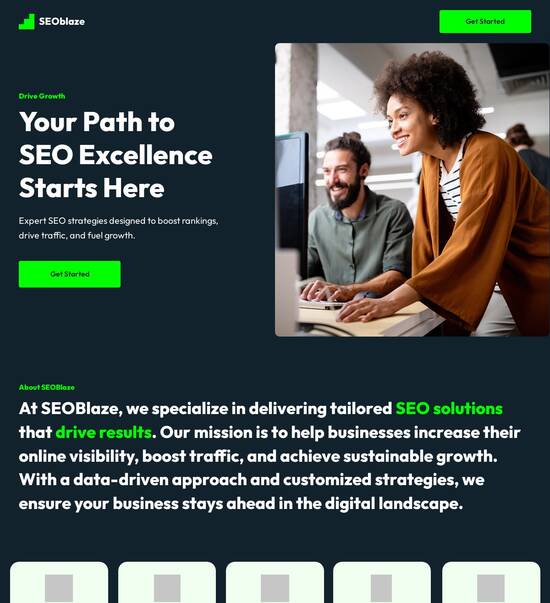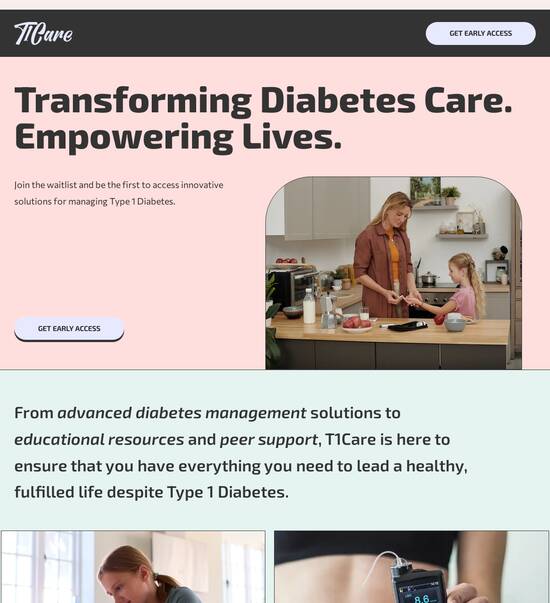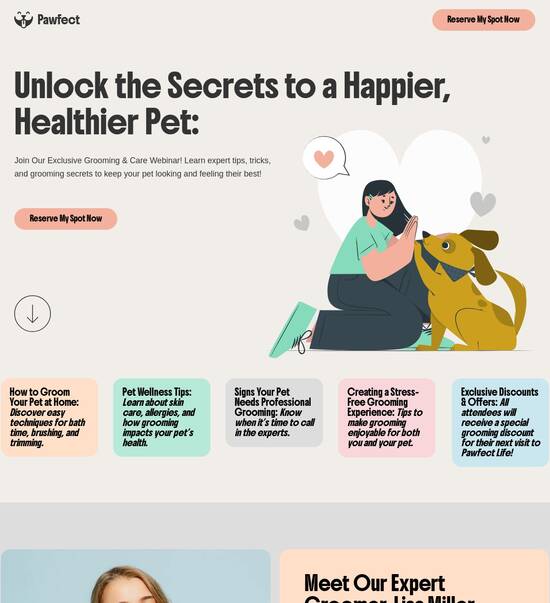
React.js optimized CV page template
Explore Similar TemplatesAbout template
Leverage our intuitive page builder and high-converting React.js optimized CV page template.
Recommended templates

Easy to build without coding
With the intuitive drag-and-drop builder, anyone on your team can create high-converting pages without any knowledge of code or design. Make enhancements to your landing page with custom widgets using Javascript, HTML/CSS, or third-party scripts.

Multiple layouts for any industry and goal
Select from 500+ landing page layouts built to boost conversions across industry-specific scenarios. Customize them by adjusting fonts, adding images, and generating on-brand content with the AI assistant. Quickly scale with Instablocks® and Global Blocks that you can save, reuse, and update globally.

Loads fast and looks polished on any device
Every template is responsive, which means they present professionally on any device and load blazingly fast with our Thor Render Engine. You can also power them up with Google AMP technology to deliver an unparalleled mobile experience and drive higher conversions.

Robust analytics & experimentation
Get real-time updates and reporting across all your devices, showing the number of visitors, conversions, cost-per-visitor, and cost-per-lead. Launch AI-powered experiments, run A/B tests, and use heatmaps to analyze user behavior, then optimize your landing page to maximize conversions.







Easy to build without coding
With the intuitive drag-and-drop builder, anyone on your team can create high-converting pages without any knowledge of code or design. Make enhancements to your landing page with custom widgets using Javascript, HTML/CSS, or third-party scripts.
Multiple layouts for any industry and goal
Select from 500+ landing page layouts built to boost conversions across industry-specific scenarios. Customize them by adjusting fonts, adding images, and generating on-brand content with the AI assistant. Quickly scale with Instablocks® and Global Blocks that you can save, reuse, and update globally.
Loads fast and looks polished on any device
Every template is responsive, which means they present professionally on any device and load blazingly fast with our Thor Render Engine.
Robust analytics & experimentation
Get real-time updates and reporting across all your devices, showing the number of visitors, conversions, cost-per-visitor, and cost-per-lead. Launch AI-powered experiments, run A/B tests, and use heatmaps to analyze user behavior, then optimize your landing page to maximize conversions.
All the features you need to build lead-generating landing pages
Explore more featuresLearn how to build top-performing landing pages for any goal
FAQs
Leading the way in building high-performing landing pages





An essential guide to optimizing your landing pages with Instapage
Effective landing page optimization is crucial for maximizing the return on investment (ROI) for your digital marketing campaigns. With Instapage, the possibilities are vast, allowing marketers from diverse sectors such as business services, tech/SaaS, and education in the USA to enhance their online presence with ease. This step-by-step guide offers insights into not just creating high-converting landing pages, but also optimizing them for maximum impact.
Getting Started with Instapage
Before you dive into creating landing pages, understanding the foundational aspects of Instapage is vital. The platform provides over 100 ready-to-use templates designed specifically for high conversion rates, which are flexible enough for any marketing budget. Here’s how you can get the most out of Instapage:
- Select an appropriate template: Choose a template that aligns with your campaign goals to streamline your design process.
- Utilize lead generation elements: Incorporate forms and call-to-action buttons from Instapage’s library to improve lead capture.
- Familiarize yourself with the intuitive editor: Spend time learning the tools available in Instapage to make your page design process faster and less complicated.
Step 1: Designing Your Landing Page
Once you have your template selected, the next critical step is to design your landing page. With Instapage’s drag-and-drop visual editor, the design process becomes intuitively simple.
- Tailor your content: Adjust headlines and body text to resonate with your target audience using dynamic text replacement.
- Visual elements: Add images and videos to keep visitors engaged and enhance the aesthetics of your landing page.
- Ensure mobile optimization: Check previews in different devices to ensure all elements display correctly across platforms.
Step 2: A/B Testing for Optimization
To ensure you have a high-converting landing page, consider implementing A/B testing. Instapage allows you to test different versions of your landing page effortlessly.
- Experiment with headlines: Test variations of your main headline to see what type resonates most with viewers.
- CTAs optimization: Modify the wording, color, and positioning of your call-to-action buttons for improved click-through rates.
- Use analytics: Regularly check performance metrics available on Instapage's dashboard to gather insights on your tests.
Step 3: Personalizing the User Experience
Personalization is key to effective landing page strategies. Instapage enables marketers to craft unique visitor experiences based on data tracking.
- Use audience targeting: Leverage the data tools on Instapage to deliver tailored content to different segments of your audience.
- AdMaps for alignment: Use AdMaps to connect specific ads to corresponding landing pages for coherent messaging.
- Track behavior: Utilize heatmaps to gain insights on how users are interacting with your page, allowing for real-time adjustments.
Incorporating these steps will help elevate the effectiveness of your landing pages. The integration of these features creates a solid approach to scaling your marketing efforts.
To truly see the difference in your campaign results, start leveraging Instapage today. Begin your journey towards higher conversions and better ROI!
People also ask about React.js optimized CV page template
Capturing Opportunities: Designing an Optimized ReactJS CV Page Template
The power of first impressions: Why a well-designed CV matters
A well-crafted CV is often the first point of contact between a job seeker and a potential employer, making the significance of its design paramount. In today's competitive job market, a visually appealing and easy-to-navigate digital resume can make all the difference in capturing attention. Hiring managers typically spend less than 10 seconds reviewing a resume, and many sources suggest that up to 80% of candidates are eliminated during this initial scan based on their CV’s layout and presentation.
In a recent survey, over 70% of employers noted that they prefer digital resumes over physical copies, emphasizing the need for modernization in how candidates present their experience and skills. A well-structured CV not only reflects professionalism but also demonstrates attention to detail—a key attribute many employers look for. Incorporating effective design strategies into your CV will not only improve your chances of passing the initial screening but also set you apart from the competition.
ReactJS as a game-changer for CV development
ReactJS, a JavaScript library maintained by Facebook, has transformed the way developers create user interfaces, particularly for single-page applications. Its component-based architecture allows developers to build encapsulated components that manage their own state, making it easier to create interactive UIs. By leveraging ReactJS for your CV page template, you can ensure that your digital resume is not only functional but also responsive and dynamic.
One of the standout features of ReactJS is its efficient rendering system, which updates just the parts of the page that change instead of reloading the entire document. This capability lends itself to smoother transitions and faster loading times, significantly enhancing user experience. Furthermore, maintaining a ReactJS-based CV is simplified, as developers can reuse components across different sections of the resume, ensuring consistency and saving time in future updates.
Structuring your resume: Key components for an effective CV page
An effective CV requires careful consideration of its structure and content. Start by showcasing a strong summary that encapsulates your expertise, followed by crucial sections that highlight your skills, work experience, and projects.
Resume summary
Your summary should quickly engage the reader by highlighting your most relevant qualifications and career goals. An effective summary is concise, usually a few sentences long, and tailored to align with the job description you are targeting.
Skills section
In a skills section, clearly list the relevant technical and soft skills pertinent to your desired role, ensuring they are well-formatted for easy readability. Using bullet points here allows you to draw attention to individual skills through concise presentation.
Work experience section
When detailing your past work experiences, consider using either a chronological or functional format. Whichever you choose, emphasize metrics and accomplishments, as these give concrete evidence of your capabilities.
Projects section
Don't overlook the importance of including a projects section where you can showcase relevant work. It’s your chance to demonstrate practical experience with thoughtful project descriptions that highlight your problem-solving skills and technical knowledge.
Designing user interfaces with ReactJS components
Utilizing ReactJS for your CV's UI design involves understanding its component structure. A typical layout could include header, summary, skills, work experience, projects, and footer components. Each part of the resume can exist as a standalone component that communicates with others, allowing a fluid and modular design.
Understanding the component structure
Components not only help you manage your CV logically but also enhance maintainability. Consider using reusable components for sections such as skills or contact information, changing data values as needed without adjusting the entire layout.
Libraries utilization
To elevate your CV’s design, it's worthwhile to integrate libraries such as Styled-components for styling and React Router for efficient navigation. These tools can simplify the process of ensuring your CV looks polished and professional while also making it user-friendly.
Optimizing performance: Best practices for a CV page
Performance optimization is essential for any web application, including CV pages. One effective strategy is code splitting, which allows a developer to break up code into multiple bundles and load only what's needed at that moment, significantly improving initial loading times.
Lazy loading components
In addition to code splitting, implementing lazy loading for various components ensures that resources are only loaded as they come into the viewport. This not only improves loading times but also reduces the initial burden on the server, providing a smoother experience for users.
Accessibility features
Accessibility should never be an afterthought in web design. Implementing ARIA roles and semantic HTML helps ensure that your CV is usable for people with disabilities. Accessible design broadens the audience for your resume and aligns with best practices for inclusive web development.
Responsive design: Ensuring your CV looks good everywhere
With a significant portion of users accessing content from mobile devices, optimizing your CV for responsiveness is crucial. Employing CSS techniques such as media queries allows you to adapt your layout seamlessly to fit various screen sizes while maintaining readability and usability.
Mobile optimization
You can use Flexbox in combination with media queries to create flexible layouts that adjust automatically as screen sizes change. This strategy ensures that every viewer, regardless of the device they use, has a pleasant experience navigating your CV.
Deployment and hosting solutions for your CV
Once you have developed your ReactJS CV page, the next step is choosing the right hosting platform. Options like Netlify and Vercel provide simple solutions for deploying your application with minimal configuration, making them accessible for developers at any level.
Continuous integration and deployment
Adopting continuous integration and continuous deployment (CI/CD) practices facilitates regular updates to your CV page. This system allows developers to automate testing and deployment processes, ensuring that your digital resume stays up-to-date with your latest skills and experiences.
Enhancing interactivity: Adding value to your CV with features
Interactive elements can greatly improve the user experience of your CV page. Features such as collapsible sections for work experiences and projects allow users to engage with the content dynamically, providing a more personalized experience.
Theme customization options
Allowing for theme customization can also be a unique aspect of your CV. Users appreciate being able to choose from different styles that resonate with their preferences, enhancing the engagement factor and reflecting pieces of your personal brand.
Real-world examples of successful ReactJS CV templates
Studying successful ReactJS CV templates can provide valuable insights for your design. Numerous front-end developers have shared their resume pages, showcasing innovative approaches and unique designs that capture potential employers' attention.
Case studies of front-end developers
When analyzing these examples, pay attention to factors such as layout, color schemes, and the effectiveness of user interactions. By identifying best practices in these resumes, you can incorporate similar strategies into your own design, thereby raising the overall quality of your CV page.
Future trends in digital resumes and ReactJS development
As the digital landscape evolves, so does the need for compelling online resumes. Increased demand for digital presence means that job seekers must adapt. Traditional paper resumes are rapidly being replaced by engaging digital formats that provide a more interactive and appealing way to showcase oneself.
The role of ReactJS in evolving resume standards
ReactJS is poised to play a significant role in developing future resume formats due to its powerful component-based structure and capabilities. As job requirements continue to shift towards digital skills, developing a ReactJS CV template allows candidates to align better with emerging trends and make themselves standout in the job market.
Conclusion: Empower your job search with a ReactJS CV page
The importance of presenting a well-optimized resume can't be overstated, especially in the tech sector. A well-designed ReactJS CV page not only highlights your skills but also showcases your ability to leverage modern technologies to meet employer expectations. Investing time in crafting this tool will not only improve your chances of success but also reflect positively on your commitment to professional growth.
Ready to skyrocket conversions?
Supercharge your ad campaigns with high-performing landing pages
Get started














